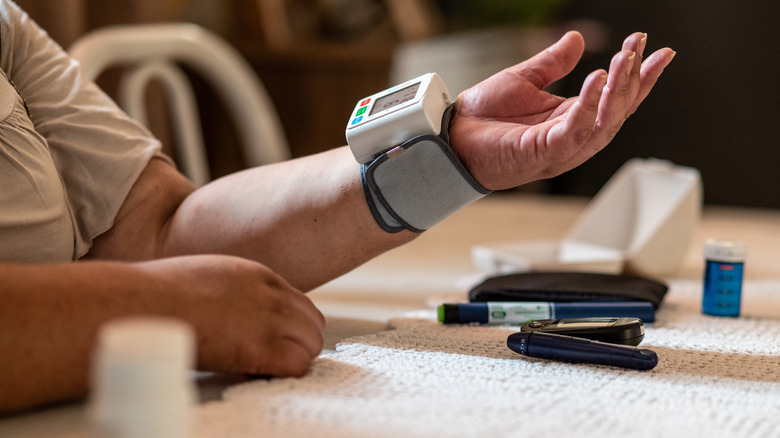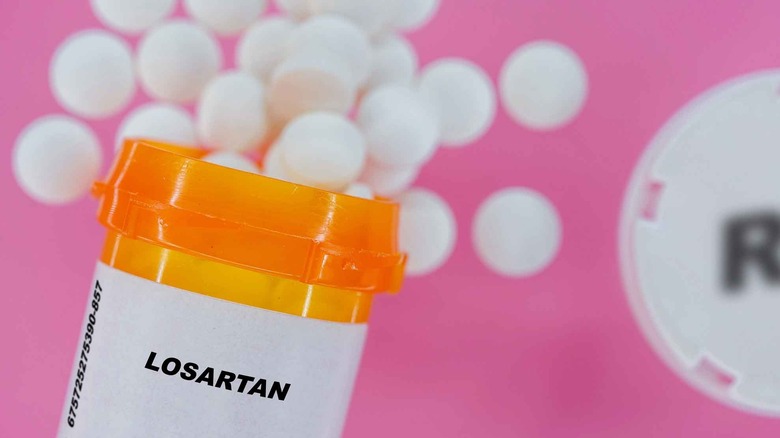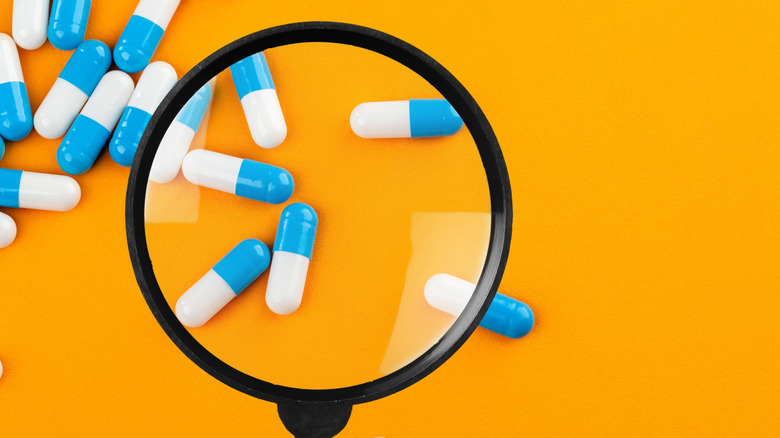Losartan Explained: Usage, Doses, And Side Effects
The American Heart Association (AHA) defines hypertension as having a consistent blood pressure of more than 130 over 80 millimeters mercury (mmHg). When a person develops hypertension, the pressure inside their blood vessels shoots up. This can happen for many reasons (e.g., smoking, obesity, lack of exercise), but the exact cause remains unknown. This type of hypertension is called essential hypertension, and it can be seen in up to 95% of all cases in the United States (per WebMD). It is known to run in families, and is heavily linked to a person's diet and lifestyle. On the other hand, when the cause of high blood pressure is known, it is called secondary hypertension. This can develop in people who have problems with their kidneys or adrenal glands, those who take certain medications or birth control pills, and women who are pregnant.
According to the Centers for Disease Control and Prevention (CDC), as many as 47% of adults in the United States have hypertension, but only 24% of them have it under control. In 2020, there were 1 million emergency department visits caused by essential hypertension; as of 2021, essential hypertension and hypertensive kidney disease are collectively one of the top 15 leading causes of death in the U.S.
Although the disease burden of hypertension is high, it is possible to control it by making lifestyle changes and/or taking medication. Several classes of drugs exist that can help control blood pressure and keep it within range. Losartan is one such drug.
Losartan is a blood pressure medication
Losartan is under a drug class called angiotensin II receptor blocker (ARB). Angiotensin II is a key component of the renin-angiotensin-aldosterone system (RAAS), the system responsible for regulating blood pressure (via StatPearls). The RAAS controls how much blood is circulating in the body and how much vessels should contract or relax. This ensures that all areas of the body are getting adequate circulation, and blood pressure remains within the normal range.
The RAAS is a complex system that involves the kidneys, lungs, blood vessels, and brain. When specialized cells in the kidneys detect that blood pressure is low, it triggers the release of renin from the kidneys, which in turn causes the conversion of angiotensinogen to angiotensin I in the liver (per Cleveland Clinic). Angiotensin I gets converted to angiotensin II by another substance called angiotensin-converting enzyme (ACE), and angiotensin II binds to its receptors found in the kidneys, adrenal glands, small arteries, and brain. This binding signals the body that blood pressure is low, and the involved organs work together to raise blood pressure. In healthy individuals, this whole process raises the blood pressure to within normal range. On the other hand, the RAAS in people with hypertension are oftentimes inappropriately active, raising blood pressure beyond normal levels.
According to Drugbank, as an ARB, losartan binds to angiotensin II receptors, which blocks angiotensin II from binding to them. This effectively stops the downstream effects of angiotensin II, ultimately preventing blood pressure from going up beyond normal.
Differences between ACE inhibitors and ARBs
Although angiotensin-converting enzyme (ACE) inhibitors and angiotensin II receptor blockers (ARBs) are technically different classes of drugs, they are similar in that they both decrease blood pressure by preventing the inappropriate activation of the renin-angiotensin-aldosterone system (RAAS). While ARBs bind to the angiotensin II receptors, ACE inhibitors bind to ACE, which is the enzyme that converts angiotensinogen to angiotensin I (per MedicineNet). By blocking this conversion, angiotensin I cannot be converted to angiotensin II, and angiotensin II will not be able to bind to its receptors and raise blood pressure. Common ACE inhibitors include lisinopril, benazepril, captopril, and enalapril.
One of the main differences between ACE inhibitors and ARBs is their side effect profile. ACE inhibitors can cause more side effects, such as dry cough, hacking, dry mouth, dizziness, and low blood pressure. You can also develop problems with your kidneys; rarely, you may experience swelling of your lips, tongue, and/or throat (i.e., angioedema). When this happens, you need to get medical treatment right away, because the swelling can progress rapidly and block your airways. ARBs may cause some of these symptoms as well, but to a lesser degree (via GoodRx).
A study published in the American College of Cardiology showed that in terms of their effects on the heart, ACE inhibitors and ARBs were pretty much the same, but people on ACE inhibitors are more at risk of developing acute pancreatitis and abnormal weight changes.
Impacts of having uncontrolled high blood pressure
Blood pressure that remains elevated for a prolonged period of time can lead to a vast array of problems. According to Mayo Clinic, it can damage arteries and cause them to narrow and stiffen. It can also weaken the walls of arteries and form aneurysms. In the heart, it can damage blood vessels (i.e., coronary arteries), cause the left side of the heart to enlarge, and increase the risk of heart failure. In the nervous system, it can predispose people to ministrokes, strokes, and dementia. It can damage the kidneys and lead to kidney failure; it can also damage the blood vessels and nerves that supply the eyes, leading to bleeding and/or vision problems.
The AHA adds that high blood pressure can also lead to heart attacks. A heart attack occurs when blood supply to the heart gets cut off, causing irreversible tissue damage. This usually happens when plaque (composed mainly of fat and cholesterol) builds up within the arteries. The vessels can initially be only partially occluded, but over time, turbulent blood flow within the vessels and/or rupture of the plaque can cause blood clots to form and cause full occlusion. In people with hypertension, their arteries are already narrow and stiff to begin with, making complete blockage more likely to happen. This is prevalent in the United States as many people do not have their blood pressure controlled, making cardiovascular disease the primary cause of morbidity and death (per Cleveland Clinic).
Other uses for losartan
Aside from being one of the primary drugs used in treating high blood pressure, losartan is also often prescribed for people with diabetes and hypertension who have problems with their kidneys (i.e., diabetic nephropathy). Specifically, it is given to people with elevated creatinine levels and protein in their urine. Losartan can also be prescribed for hypertensive people with thickened left ventricles to decrease their risk of stroke (per StatPearls).
Although losartan is approved by the U.S. Food & Drug Administration (FDA), there are certain instances where it is prescribed for other health conditions that may not have been approved by the FDA. These are called off-label uses. Your doctor may opt to do this if you have an illness that has no definitive or approved cure; or if you have tried other, more appropriate treatments, but they were not effective in treating or managing your condition (via the FDA).
Off-label uses for losartan include heart failure with reduced ejection fraction (i.e., percentage of blood being pumped out of the heart at every beat), aortic aneurysms in people with Marfan syndrome, acute heart syndromes other than heart attacks, post-transplant erythrocytosis (i.e., persistently high hemoglobin or hematocrit levels following transplant procedures), and chronic kidney disease in non-diabetics (per Medicine.com). In addition, losartan can also be given to people who cannot tolerate angiotensin-converting enzyme (ACE) inhibitors due to their side effects (via StatPearls).
How is losartan prescribed?
Losartan (Cozaar) is a film-coated tablet that comes in doses of 25, 50, and 100 milligrams. It also contains between 2 to 8 milligrams of potassium (via Drugs.com).
Adults with hypertension are usually prescribed 50 milligrams every day initially, but it can sometimes be increased to 100 milligrams if blood pressure remains uncontrolled. However, people who have low blood volume or are taking "water pills" (i.e., diuretics) will initially be prescribed only 25 milligrams every day. Hypertensive people with thickened left ventricles may also be given 50 to 100 milligrams a day, and this is sometimes combined with 12.5 to 25 milligrams of hydrochlorothiazide. People with diabetic nephropathy are usually given 50 to 100 milligrams a day, but the dose is decreased to 25 milligrams if they also have problems with their liver (per Medscape). Medicine.com adds that people with heart failure are initially started on 25 milligrams once a day, but this can be increased every week or every other week (up to 150 milligrams) depending on how they respond to it, and if they are able to tolerate it.
Drugs.com explains that once you start taking losartan, it can take between one and six weeks to see its effects. After initial processing of the drug, only 33% of it remains available to act on angiotensin II receptors. Its peak effect occurs around one to four hours, where the drug is able to inhibit 85% of the receptors. However, this decreases to around 25% to 40% after 24 hours.
Side effects of losartan
The main side effects of losartan are increased potassium in the blood (i.e., hyperkalemia), kidney problems, and swelling in certain areas of the body (i.e., angioedema). Other, rarer side effects (more than 10%) include cough, weakness, fatigue, low red blood cell count, low blood glucose levels, diarrhea, and urinary tract infections. Less than 10% of people taking losartan may also experience nausea, low blood pressure, inflammation of the stomach lining (i.e., gastritis), cellulitis, upper respiratory tract infections, body pain, chills, constipation, ringing in the ears, hearing loss, imbalance, decreased libido, ear fullness, erectile dysfunction, increased skin sensitivity, skin color changes, lack of appetite, congestion, sore throat, difficulty sleeping and concentrating, loss of taste, dark-colored urine, yellowing of the eyes, and depressed mood.
In addition, other rare but serious side effects that should prompt you to seek medical help as soon as you can include blurring of vision, confusion, fainting spells, numbness or tingling sensation, shortness of breath, dizziness, vomiting, unusually fast and/or irregular heart beat, stomach pain, sweating, black stools, bleeding gums, blood in your urine or stool, loss of consciousness, seizures, headache, problems with swallowing, itching, hives, increased thirst, muscle cramps, chest pain, problems with urinating, and unusual bruising.
How to manage or avoid experiencing side effects from losartan
Although losartan is associated with many varying side effects, do not let that hinder you from taking it if it was prescribed by your doctor. According to Singlecare, studies show that it is uncommon to experience side effects from losartan. On the other hand, the beneficial impacts of taking losartan are far greater, and greatly outweighs its associated risks.
If you are experiencing — or are concerned about — side effects from losartan, Medical News Today advises to speak with your doctor about your concerns. The symptoms you are feeling may or may not be related to taking losartan, and your doctor will be able to distinguish if they need to change your medication because of side effects, or if they should look for another possible health problem.
Although it is never advisable for anyone to take any medications or substances without consulting their health care provider, there are some things you can also do at home. For example, if you are experiencing some mild dizziness, try to move slowly and sit down to avoid falling. If you are feeling lightheaded, check your blood pressure to see if it dropped too low. Feeling weak, feeling nauseated, or experiencing tingling sensations? Your potassium levels may be elevated, which can lead to palpitations, chest pain, and irregular heart rhythms. If this happens, do not delay going to your nearest emergency room (via Singlecare).
What to take note of before taking losartan
Before taking losartan, it is important to be aware of certain precautions. Your doctor will not prescribe losartan if it is not suitable for you. However, it is still good practice to be knowledgeable about any drug that you are taking.
Although losartan is safe and effective in children between 6 to 16 years old, data is still lacking on whether or not it is suitable for children below 6 years old. In the elderly population, studies show that losartan is equally safe and effective compared to younger adults. However, aging does predispose certain people to increased sensitivity to drugs. A large study also showed that losartan was inferior to atenolol in preventing complications (e.g., stroke, heart attack) in African Americans with high blood pressure and concomitant left ventricular enlargement. However, it also showed that losartan decreased blood pressure equally in Black and non-Black patients with hypertension. In people with liver problems, studies show that the concentration of losartan in their body is higher compared to people with healthy livers (via Drugs.com).
Additionally, it is important to take note of any drug recalls. For example, in 2018, the FDA discovered that some generic brands of several angiotensin II receptor blockers (ARBs) contained impurities that they believe may cause harm to the people taking them. These include valsartan, irbesartan, and losartan. However, not all of these drugs got recalled, only the ones from manufacturing sites where the impurities were detected.
Taking losartan during pregnancy or breastfeeding
Losartan should never be used during pregnancy. Losartan and other ARBs can lead to pregnancy loss, and it can also cause several serious complications and birth defects in babies. Among these include smaller bones, underdeveloped lungs, kidney damage or failure, inability to produce urine, low blood pressure, and sometimes, death. These occur more commonly in babies of pregnant women who take losartan during the second or third trimesters (via Healthline).
On the other hand, safety of losartan use during breastfeeding is not as clear cut. While it is not known whether losartan is excreted in human breast milk, there are studies that show high levels of losartan in rat milk (per Drugs.com). Because of this, the benefits of taking losartan should be weighed against its risks on a case by case basis.
Not being able to take losartan during pregnancy and/or breastfeeding does not mean that your blood pressure should remain uncontrolled. According to the American College of Obstetricians and Gynecologists (ACOG), maintaining normal blood pressure during pregnancy is especially important to avoid complications like preterm birth, delivering babies that are smaller than normal, premature separation of the placenta (i.e., placental abruption), preeclampsia, and eclampsia. Preeclampsia reduces the amount of blood going to your unborn baby, predisposing them to premature birth, learning disabilities, epilepsy, cerebral palsy, hearing problems, and vision problems. It can also increase your risk of strokes, seizures, heart failure, vision loss, bleeding in the liver, and HELLP syndrome (per WebMD).
Drinking alcohol while taking losartan
Per the American Addiction Centers, after drinking even just one alcoholic beverage, you will experience an acute but transient increase in your blood pressure. This is caused by several things.
Firstly, alcohol increases renin levels, thus promoting its downstream effects of activating the renin-angiotensin-aldosterone system (RAAS) and raising blood pressure (per Medical News Today). Alcohol also increases cortisol (aka "the stress hormone"), which then leads to an increased release of chemicals called catecholamines. Catecholamines can cause retention of fluid, which effectively raises blood pressure. Drinking alcohol can also raise calcium levels in the blood. Calcium then binds to receptors in the blood vessels, causing them to constrict and narrow, which in turn increases pressure. Lastly, the body has receptors that detect and correct blood pressure called baroreceptors. Alcohol decreases the sensitivity of these baroreceptors, making them unable to properly regulate blood pressure.
If one drink is enough to raise blood pressure, it makes sense that the more you drink, the greater and longer the effects will be. Some of the side effects you may feel from mixing alcohol and blood pressure medications include worsened dizziness, sleepiness, fainting, and heart rhythm irregularities. Therefore, when it comes to taking blood pressure medications like ARBs, it is best to avoid alcohol as much as you can. If you are considering having a drink or two, ask your provider if it is okay, since the answer will depend largely on your personal medical history (per GoodRx Health).
Losartan and its possible effects in reducing COVID-19 severity
Due to the COVID-19 pandemic, a lot of research was put into learning more about the virus and how exactly it affected several aspects of our health. Being that almost half of the United States adult population has hypertension, it was only a matter of time before studies looking into the effects of taking blood pressure medications on COVID-19 were conducted.
In early 2020, a study published in BioMed Central (BMC) found that losartan significantly reduced the risk of death from COVID-19 by more than five times in people with hypertension. The authors of the study also found that losartan could potentially protect against COVID-19, but because the results for this were not statistically significant, they recommended that larger studies be done in order to confirm this.
Also in early 2022, a randomized clinical trial was published in the Journal of the American Medical Association (JAMA) Network that looked into whether or not losartan reduced COVID-19-related lung injuries in people who were admitted in the hospital. Unfortunately, not only did they find out that losartan did not have any effect on decreasing lung injury, but they also found that losartan was no different than placebo in terms of hospital discharge and in-hospital death.
Because the data is unclear and conflicting, there is definitely a lot of room for more research to be conducted. For now, however, no recommendation exists regarding the use of losartan in people with COVID-19.
Medications and other substances that can interact with losartan
It is not uncommon for drugs to interact with one another. Two drugs can work together to exert a more potent effect, or they can work against each other and reduce the effect. There are also drugs that can worsen another drug's side effects or possibly cause toxicity.
Drugs.com explains that with losartan specifically, drugs that can increase potassium levels in the blood can increase the risk of hyperkalemia and its associated symptoms. These drugs include ACE inhibitors (e.g., lisinopril, enalapril, benazepril), other ARBs (e.g., candesartan, valsartan, telmisartan), potassium-sparing diuretics (e.g., spironolactone, epleronone, amiloride), nonsteroidal anti-inflammatory drugs (NSAIDS) (e.g., naproxen, ibuprofen, aspirin), calcineurin inhibitors (e.g., cyclosporine, tacrolimus), trimethoprim, pentamidine, propranolol, aliskiren, succinylcholine, and mannitol. Although hyperkalemia can lead to a medical emergency, these drugs can still sometimes be prescribed to people taking losartan, but their potassium levels must be closely and regularly monitored.
Another drug that can interact negatively with losartan is lithium. Lithium is prescribed to people with mental health conditions like mania (from bipolar disorder), depression, schizophrenia, and impulse control problems (per MedlinePlus). Taking lithium with ARBs or ACE inhibitors should be avoided as much as possible. ARBs and ACE inhibitors slow down the elimination of lithium from the body, causing lithium levels to spike and result in toxicity (via WebMD). Lithium toxicity can harm several areas of the body, affecting the nervous system, kidneys, heart, gut, and thyroid. Without rapid and proper treatment, lithium toxicity can become fatal.
Overdosing on losartan
Losartan is a prescription drug that you cannot get over-the-counter. In 1938, the Food, Drug, and Cosmetic Act was enforced, and within two months, several drugs that had risks of causing harm to people were tagged by the FDA. This initiated the establishment of prescription-only drugs, which need prior clearance from a qualified physician before they are deemed safe and suitable to consume by patients. Prior to this, several drugs such as sulfonamides, thalidomide, amphetamines, and barbiturates were being purchased and taken without any regulation, which resulted in many problems like birth defects, addiction, injury, and death. Since then, the FDA became the agency responsible for reviewing any new drug that is made in or brought into the U.S., most especially their safety and efficacy profiles, before they are introduced into the market.
While this rigid process greatly reduces the potential for harm, it is still possible for people to abuse, or experience adverse effects from, both prescription and non-prescription drugs. According to the AAC, losartan is not technically considered a drug of abuse, but it can be misused, especially by the elderly. Misuse can include taking too much of the drug or taking the drug all at once when it was prescribed to be taken at multiple times throughout the day. If you or a loved one had accidentally or intentionally taken too much losartan, connect with Poison Control right away (1-800-222-1222). Symptoms of losartan overdose include dizziness, fainting, and irregular heartbeat (per MedlinePlus).
Alternatives to losartan
All blood pressure medications are prescription-only. Do not take someone else's prescription medication. Speak with your provider if you are experiencing side effects, or if you want to change your medication. Remember that not all medications are safe and appropriate for everyone to use.
Common alternatives to losartan include lisinopril and amlodipine (via Drugs.com). Lisinopril is an ACE inhibitor. Similar to losartan, lisinopril is used to treat hypertension and diabetic kidney disease. It can also be prescribed off-label for coronary artery disease, Alport syndrome, prevention of migraine attacks, and polycystic kidney disease. It cannot be given to pregnant women. The main concern with taking ACE inhibitors is their propensity to cause a dry hacking cough. Sometimes the cough can get very bothersome to the point where people want to stop taking the drug. On the other hand, amlodipine is a calcium channel blocker (CCB) that is prescribed for angina, hypertension, Raynaud's syndrome, heart failure, and coronary artery disease. It is also sometimes used for migraine prevention. Its risk when taken during pregnancy cannot be ruled out, so it is typically not given. The downside of amlodipine is its tendency to cause fluid retention in the ankles and feet.
According to SingleCare, other alternatives to losartan include other ARBs, other ACE inhibitors, other CCBs (e.g., verapamil), "water pills," beta blockers (e.g., atenolol, metoprolol), spironolactone, eplerenone, clonidine, and combination drugs (e.g., ARB plus hydrochlorothiazide). For pregnant women, the most common drugs that are prescribed are labetalol, nifedipine, and methyldopa (per Sanford Health).















